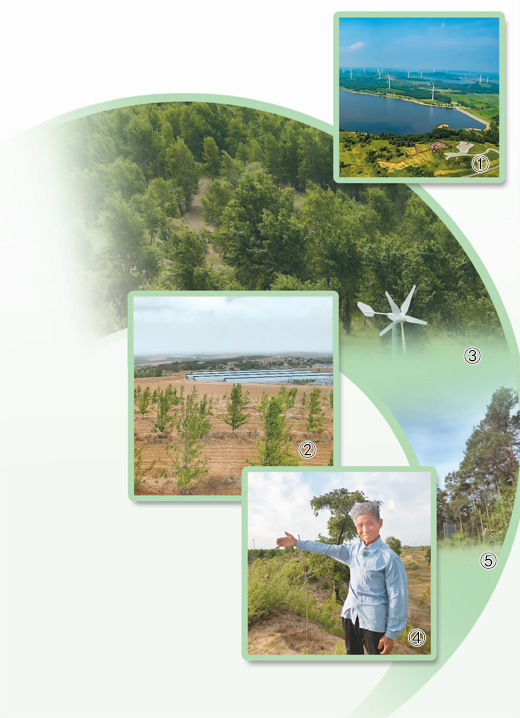Fuxin city in NE China's Liaoning sees remarkable success in desertification control
"Those are all trees I planted. I want to keep planting trees for another 10 years. I will continue to plant trees as long as I can work," said 73-year-old Hou Gui, a recipient of the "national afforestation medal" in Sihecheng township, Zhangwu county, Fuxin city, northeast China's Liaoning Province.
The tanned-skin man, a native of Sihecheng township, has been involved in cultivating tree seedlings, planting trees and patrolling mountains for 23 years. The township is located on the southern edge of the Horqin Sandy Land, one of China's largest sandy areas and one of the sources of sand and dust to the Beijing-Tianjin-Hebei region.

①: File photo shows the verdant scenery of Oulishan Mountain which used to be a large sand dune in Zhangwu county, Fuxin city, northeast China's Liaoning Province.
②:Photo shows the base for the comprehensive governance of mountains, rivers, forests, farmland, lakes, grasslands and deserts in Guanyingzi village, Yusi township, Fuxin Mongolian Autonomous County, Fuxin city, northeast China's Liaoning Province. (People's Daily Overseas Edition/Yang Junfeng)
③: Photo shows part of China's Three-North Shelterbelt Forest Program located to the west of the demonstration zone for the comprehensive governance of mountains, rivers, forests, farmland, lakes, grasslands and deserts in Zhangwu county, Fuxin city, northeast China's Liaoning Province. (People's Daily Overseas Edition/Yang Junfeng)
④: Photo shows Hou Gui, a recipient of China's "national afforestation medal," in Zhangwu county, Fuxin city, northeast China's Liaoning Province. (People's Daily Overseas Edition/Yang Junfeng)
⑤: Photo shows pine forests in Zhanggutai township, Zhangwu county, Fuxin city, northeast China's Liaoning Province. (People's Daily Overseas Edition/Yang Junfeng)
When the People’s Republic of China was founded in 1949, desertified land in Zhangwu county exceeded 5.2 million mu (0.35 million hectares), accounting for 96 percent of the county's total land area, and its forest coverage rate was just 2.9 percent, making it the largest area plagued by sand and dust storms in Liaoning Province.
In 2001, Hou resigned as head of the villagers' committee of a village in the township and embarked on a path of combating desertification by contracting a patch of barren sandy land of the Sihecheng forest farm.
Hou's afforestation was long and arduous. Poplars he planted in the early days died of disease. The problem was then solved by guidance from experts with the Institute of Sandy Land Management and Utilization of Liaoning.
Hou has planted over 200,000 trees over the past years, turning the barren land into an oasis.
Hou's story epitomizes Fuxin city's success in controlling desertification and creating a "green miracle."
Located in the demonstration zone for the comprehensive governance of mountains, rivers, forests, farmland, lakes, grasslands and deserts in Zhangwu county, Oulishan Mountain, one of the six 10,000-mu sand dunes in the county, has been turned into an oasis, thanks to four years of efforts.
"In front of us is a forest spanning over 2,000 mu. It was once a sand dune, and has now been turned into an oasis. It serves as the best testimony to Zhangwu's desertification control efforts," Qu Liping, head of the forestry station of Dade township, said while standing on Oulishan Mountain.
All the vast forestlands seen by the naked eye are part of China's Three-North Shelterbelt Forest Program (TSFP), a large-scale afforestation project, Qu added.
The successful transformation of Oulishan Mountain is a microcosm of the TSFP and one of the achievements in treating the Horqin Sandy Land.
Zhangwu is the world's first place to use Mongolian Scots pines to contain the moving sand dunes. The county introduced Mongolian Scots pines from north China's Inner Mongolia Autonomous Region, and has realized the large-scale planting of the tree species.
Yu Guoqing, head of the Institute of Sandy Land Management and Utilization of Liaoning, said that the comprehensive desertification control method focusing on shrub planting summarized by the institute was listed as one of China's three major desertification control methods. It also pioneered the use of Mongolian Scots pines for afforestation efforts.
"In 1955, we succeeded in the trial planting of Mongolian Scots pines on the sandy land in Zhanggutai township of Zhangwu county, offering an example for desertification prevention and control in the TSFP-covering areas, and even the whole country," said Wu Xiugang, deputy head of the institute.
"Cultivating seedlings of Mongolian Scots pines is one of the pillar industries in Zhanggutai township, making it the largest Mongolian Scots pine seedling base in sandy areas nationwide," said Zhao Lidong, head of Zhangwu county's forestry and grassland bureau.
Zhao added that the development of the sector provides powerful support for the TSFP.
Bordering the Horqin Sandy Land, Fuxin Mongolian Autonomous County in Fuxin city is home to over 1 million mu of desertified land.
The county has promoted the comprehensive governance of mountains, rivers, forests, farmland, lakes, grasslands and deserts.
The county has afforested 30,000 mu of forests, with volunteers planting 2 million trees, according to Chai Xuguang, head of Fuxin county's forestry and grassland bureau.
Photos
Related Stories
- In pics: Explore ecological beauty of forests in the Great Khingan Mountains
- Fire prevention, control work reinforced to avoid potential forest risks in SW China
- Green efforts gain more ground
- Logging ban sparks nature's rebirth in China's Khingan Mountains
- China launches campaign to strengthen forest, grassland fire prevention
- Rescuers continue to battle forest fire in Sichuan
- China's forests become treasure trove of food and economic potential
- A look at China's green development
Copyright © 2024 People's Daily Online. All Rights Reserved.









